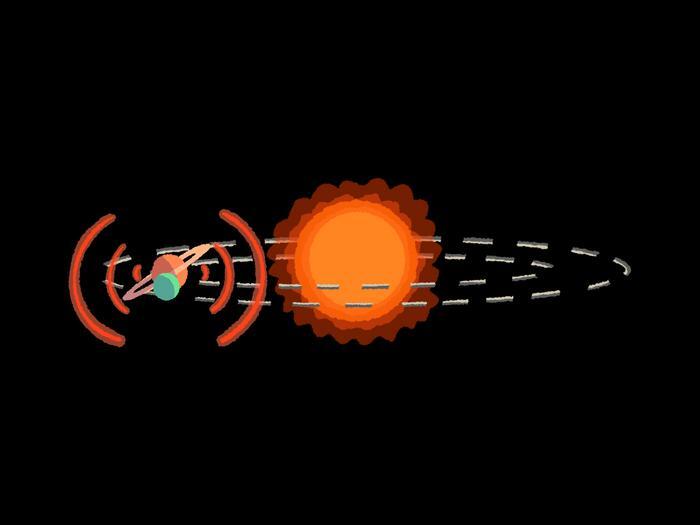17.10.2024
Scientists use Allen Telescope Array to search for interplanetary communications in the TRAPPIST-1 star system

Illustration showing communication between planets beyond our solar system looking from the perspective of Earth. New research using the Allen Telescope Array looked for this type of communication, similar to communication between Earth and our rovers on Mars, in the TRAPPIST-1 star system.
UNIVERSITY PARK, Pa. — A new technique allows astronomers to home in on planets beyond our solar system that are in line with each other and with Earth to search for radio signals similar, for example, to ones used to communicate with the rovers on Mars. Penn State astronomers and scientists at the SETI Institute spent 28 hours scanning the TRAPPIST-1 star system for these signs of alien technology with the Allen Telescope Array (ATA). This project marks the longest single-target search for radio signals from TRAPPIST-1. Although the team didn’t find any evidence of extraterrestrial technology, their work introduced a new way to search for signals in the future.
A paper describing the research was accepted for publication in the Astronomical Journal and is available online as a preprint.
“This research shows that we are getting closer to technology and methods that could detect radio signals similar to the ones we send into space,” said Nick Tusay, a graduate student research fellow at Penn State and first author of the paper. “Most searches assume a powerful signal, like a beacon intended to reach distant planets, because our receivers have a sensitivity limit to a minimum transmitter power beyond anything we unintentionally send out. But, with better equipment, like the upcoming Square Kilometer Array, we might soon be able to detect signals from an alien civilization communicating with its spacecraft.”
The project focused on a phenomenon called planet-planet occultations (PPOs). PPOs happen when one planet moves in front of another from Earth’s perspective. If intelligent life exists in that star system, radio signals sent between planets could leak and be detected from Earth.
Using the upgraded ATA — a series of radio antennae dedicated to the search for extraterrestrial technology located at the Hat Creek Observatory in the Cascade Mountains about 300 miles north of San Francisco — the team scanned a wide range of frequencies, looking for narrowband signals, which are considered possible signs of alien technology. The team filtered millions of potential signals, narrowing down to about 11,000 candidates for detailed analysis. The team detected 2,264 of these signals during predicted PPO windows. However, none of the signals were of non-human origin.
The ATA's new capabilities, which include advanced software to filter signals, helped the team separate possible alien signals from Earth-based ones. The researchers said they believe that refining these methods and focusing on events like PPOs could help increase the chances of detecting alien signals in the future.
“This project included work by undergraduate students in the 2023 SETI Institute Research Experience for Undergraduates program,” said Sofia Sheikh, a SETI researcher at the SETI Institute who earned her doctoral degree at Penn State. “The students looked for signals from human-made orbiters around Mars to check if the system could detect signals correctly. It was an exciting way to involve students in cutting-edge SETI research.”
The TRAPPIST-1 system is a small, cool star about 41 light years from Earth. It has seven rocky planets, some of which are in the habitable zone, where conditions might allow liquid water to exist — an essential ingredient for life as we know it. This makes TRAPPIST-1 a prime target searching for life beyond Earth.
“The TRAPPIST-1 system is relatively close to Earth, and we have detailed information about the orbit of its planets, making it an excellent natural laboratory to test these techniques,” Tusay said. “The methods and algorithms that we developed for this project can eventually be applied to other star systems and increase our chances of finding regular communications among planets beyond our solar system, if they exist.”
The team did not find any alien signals this time, but they will continue improving their search techniques and exploring other star systems. Future searches with bigger and more powerful telescopes could help scientists detect even fainter signals and expand our understanding of the universe, the team said.
In addition to Tusay and Sheikh, the research team includes Jason T. Wright at Penn State; Evan L. Sneed at the University of California, Riverside; Wael Farah, Andrew Siemion and David R. DeBoer at the University of California, Berkeley; and Alexander W. Pollak and Luigi F. Cruz at the SETI Institute. This research was primarily funded through grants from the U.S. National Science Foundation with additional support from the Penn State Extraterrestrial Intelligence Center and the Penn State Center for Exoplanets and Habitable Worlds, which are supported by the Penn State and the Penn State Eberly College of Science.
About the SETI Institute
Founded in 1984, the SETI Institute is a non-profit, multi-disciplinary research and education organization whose mission is to lead humanity’s quest to understand the origins and prevalence of life and intelligence in the universe and to share that knowledge with the world. The institute’s research encompasses the physical and biological sciences and leverages expertise in data analytics, machine learning and advanced signal detection technologies. The SETI Institute is a distinguished research partner for industry, academia and government agencies, including NASA and NSF.
Quelle: AAAS
